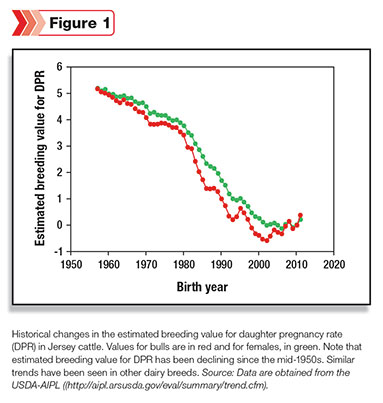Over the past 60 or so years, fertility has declined in all of the maj or dairy breeds, including the Jersey. The historical drop in fertility has been ascribed to a variety of factors such as an increase in milk yield, changes in management and herd structure, inbreeding and lack of selection for reproduction.
Even though reproduction is usually considered as not being a very heritable trait, genetics has clearly played a role in the decline in fertility.
The focus on production traits in genetic selection programs with little consideration for traits associated with reproduction has contributed to the decline in reproductive function.

Moreover, there is a negative genetic correlation between milk yield and reproduction, so selection for yield can result in selection of genes that compromise fertility.
As displayed in Figure 1 for Jersey cattle, the genetic merit for fertility decreased from the 1950s to the early 2000s before increasing slightly in the last few years.
Similar trends have been experienced by other dairy breeds.
The development of genomics is leading to discovery of specific genes responsible for dairy cattle infertility.
Recently, scientists working at the USDA Animal Improvement Programs Laboratory (USDA-AIPL) have discovered a specific haplotype associated with infertility in Jerseys called JH1.
A haplotype is one or more alleles at closely located positions on a chromosome that are inherited together. Animals with the JH1 haplotype have a defective version of a gene called CWC15 that is important for cells to be able to process signals from other genes.
The mutation in CWC15 is a so-called “nonsense mutation” that causes inactivation of the gene so it is not functional.
An embryo that inherits a defective version of CWC15 from both its sire and dam is not able to complete development but instead dies at some point in gestation. As a result, there are no living animals with two copies of the defective gene.
The defective CWC15 gene traces back to a single influential Jersey sire named “Observer Chocolate Soldier” born in 1962. Bulls such as “Mason Sooner Boomer Berretta” and “Rockella Paramount” are related to “Observer Chocolate Soldier.”

These bulls have had a large impact on the Jersey breed.
Not surprisingly, the frequency of the JH1 haplotype increased from 1955 to 2005 before decreasing somewhat recently ( Figure 2 ).
Today, about 20 percent of Jerseys are carriers of the deleterious allele.
Fortunately, the JH1 haplotype can be detected through genetic testing with Neogen’s GeneSeek Genomic Profiler (GGP) version 2 Dairy HD platform.
Selecting animals for breeding that do not carry the deleterious mutation will decrease the incidence of the mutation in the population and increase fertility of the Jersey breed.
The American Jersey Cattle Association has instituted a program to label bulls as either a carrier for JH1 (JH1C) or as free of the haplotype (JH1F) on genomic evaluation reports, official performance pedigrees, performance-progeny reports and genetic evaluation reports.
There are other genes that have been found in the Holstein and Brown Swiss breeds that are related to fertility. The USDA-AIPL have found five haplotypes in the Holstein and two haplotypes in the Brown Swiss that also have deleterious effects on fertility.
Thus, it is likely that genomics will continue to provide dairy cattle breeders with tools that can reverse some of the historical decline in fertility in dairy cattle. PD
Hansen has a Ph.D. from the University of Wisconsin and is a faculty member at University of Florida. Buchanan received her master’s degree in animal sciences from the University of Florida and is now at McArthur Farms in Okeechobee, Florida. Sonstegard is a USDA – ARS geneticist with 25 years of experience in molecular genetics and genomics.









